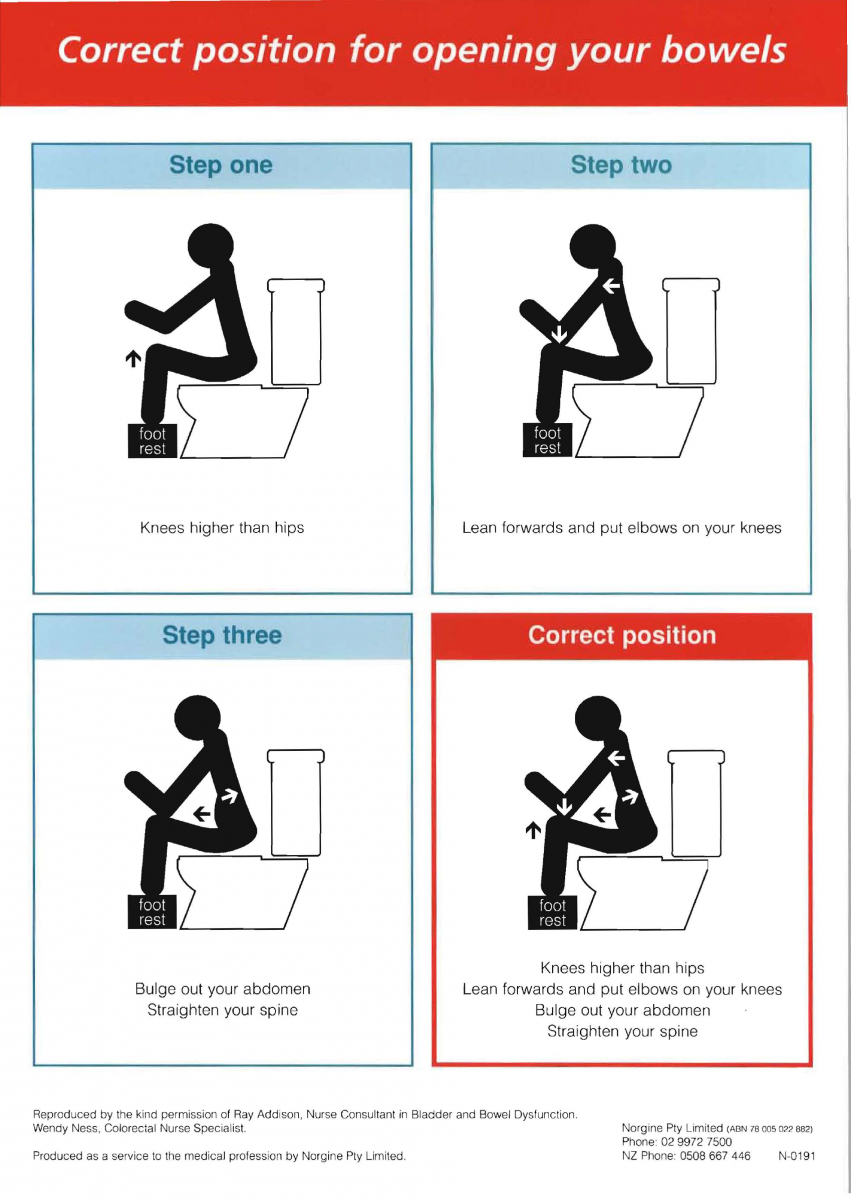Normal Bowel Habits
The following video How the Bowel Works is a fantastic way for you to understand how you bowel works and what your problem might be.
What is Normal?
Bowel motions should:
- take place anywhere from 3 times in a day, to 3 times in a week.
- be formed and soft (Type 3 or 4), as per the the Bristol Stool Chart described below.
- be able to be passed with minimal effort, to start and finish.
- be able to be controlled until a time which is convenient for you
- require only a few pieces of toilet paper to wipe clean
Bowel motions should NOT:
- be too hard (Type 1 or 2)
- be too loose (Type 5, 6 or 7)
- require frequent straining to pass
- feel incomplete
- be accompanied by pain or bleeding
Assessment
A thorough medical assessment is vital to ensure there are no medical issues underlying your bowel problems, followed by a Pelvic Floor Physiotherapy assessment.
A Bowel Diary will help both you and your Physiotherapist assess your bowel function and identify any problems, as well as tracking progress.
In addition to your bowel diary, your Physiotherapist will ask you many questions to help work out what factors might be contributing to your problem, as well as help determine the treatments which will be most helpful for you.
An examination of the area around the anus (back passage), as well as an internal assessment of the anal and pelvic floor muscles can provide valuable information to help understand your problem.
Please read the following Informed consent for examination - Female or Informed consent for examination - Male and decide if you will give consent.
Questionnaires to track your progress
Your physiotherapist will put some Questionnaires in Your Health Journey for you to complete and submit before every appointment. These questionaires will ask more specific questions about your bowel problem and help track your progress.
Bristol Stool Form Scale
This chart can be confronting for some patients to fill in initially, however it is a valuable way of tracking and communicating your bowel function and any related problems. It is normal behaviour to have a quick look after a bowel motion so that you can monitor your own bowel health.

Treatment
Ensuring the 'Perfect Poo'
A soft, yet well formed stool is one of the most important factors in achieving normal bowel function.
Too hard, and the stool may:
- be more difficult to pass,
- move more slowly through the bowel,
- be hard to empty completely
- cause pain and/or bleeding
Too loose, and the stool may:
- be more urgent and difficult to control, in some instances lead to bowel leakage
- be hard to empty completely
- require more effort to empty
Stools can be made softer or firmer with small dietary modifications, optimising fluid intake and medications. Your Physiotherapist will provide advice to help you with your individual situation, and may recommend a dietician appointment for more specific dietary assessment and advice.
Toileting Position
There is an ideal posture to make bowel motions easier to pass and help with complete bowel emptying, with minimal straining.
This position has evolved from a squatting position, however western toilets have led to the need for a modified technique to ensure a correct and relaxed position.
Ideal toilet posture involves:
- Sitting on the toilet with your feet and knees wide apart, and your feet flat.
- Having the knees higher than your hip height. Depending on your height, and your toilet height, you may benefit from using a small to medium height stool or duneze or squatty potty.
- Relaxing forward to rest your elbows or forearms on your knees. Make sure you maintain a forward curve in your lower back (no slouching) and keep your chest high, with your eye gaze forwards.
There are some instances where this posture may need to be modified by your Physiotherapist, depending on your assessment findings.

Toileting Technique
Bowel emptying should require minimal straining, both to start the bowel motion, and to complete emptying.
Good technique involves adequate relaxation of the muscles around the anal opening, as well as using your abdominal muscles in the right way to assist with expeling the stool without excessive strain or pressure in the anus. This technique will be covered in more detail on a separate page, and your Physiotherapist will assess and guide you to work on the areas you need to address most.
The basics involve:
- Keeping your abdomen long and open. Start by thinking about 'flopping and dropping' the tummy forward.
- Gently bulging your belly forward. You may feel some tension in your tummy muscles however do not let your tummy draw in.
- Widening your waist out to each side. For some people using a deep 'Mooooo' sound can assist with this.
There is more detailed information here.
